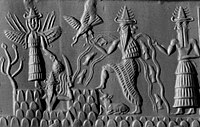Anu
| Part of a series on |
| Ancient Mesopotamian religion |
|---|
 |
|
|
In Sumerian mythology, Anu (also An; (from Sumerian *An 𒀭 = sky, heaven)) was a sky-god, the god of heaven, lord of constellations, king of gods, spirits and demons, and dwelt in the highest heavenly regions. It was believed that he had the power to judge those who had committed crimes, and that he had created the stars as soldiers to destroy the wicked. His attribute was the royal tiara.
He was one of the oldest gods in the Sumerian pantheon, and part of a triad including Enlil, god of the air and Enki, god of water. He was called Anu by the Akkadians. By virtue of being the first figure in a triad consisting of Anu, Enlil, and Enki (also known as Ea), Anu came to be regarded as the father and at first, king of the gods. Anu is so prominently associated with the E-anna temple in the city of Uruk (biblical Erech) in southern Babylonia that there are good reasons for believing this place to have been the original seat of the Anu cult. If this is correct, then the goddess Inanna (or Ishtar) of Uruk may at one time have been his consort.
Sumerian religion

Anu had several consorts, the foremost being Ki (earth), Nammu, and Uras. By Ki he was the father of, among others, the Annuna gods. By Uras he was the father of Nin'insinna. According to legends, heaven and earth were once inseparable until An and Ki bore Enlil, god of the air, who cleaved heaven and earth in two. An and Ki were, in some texts, identified as brother and sister being the children of Anshar and Kishar. Ki later developed into the Akkadian goddess Antu.
Anu existed in Sumerian cosmogony as a dome that covered the flat earth; Outside of this dome was the primordial body of water known as Tiamat (not to be confused with the Subterranean "Apsû").[1]
In Sumerian, the designation "An" was used interchangeably with "the heavens" so that in some cases it is doubtful whether, under the term, the god An or the heavens is being denoted. The Akkadians inherited An as the god of heavens from the Sumerian as Anu-, and in Akkadian cuneiform, the DINGIR character may refer either to Anum, or to the Akkadian word for god, ilu-, and consequently had two phonetic values, an and il. Hittite cuneiform as adapted from the Old Assyrian kept the an value but abandoned il.
Assyro-Babylonian religion
The doctrine once established remained an inherent part of the Babylonian-Assyrian religion and led to the more or less complete disassociation of the three gods constituting the triad from their original local limitations. An intermediate step between Anu viewed as the local deity of Uruk, Enlil as the god of Nippur, and Ea as the god of Eridu is represented by the prominence which each one of the centres associated with the three deities in question must have acquired, and which led to each one absorbing the qualities of other gods so as to give them a controlling position in an organized pantheon. For Nippur we have the direct evidence that its chief deity, En-lil, was once regarded as the head of the Sumerian pantheon. The sanctity and, therefore, the importance of Eridu remained a fixed tradition in the minds of the people to the latest days, and analogy therefore justifies the conclusion that Anu was likewise worshipped in a centre which had acquired great prominence.
The summing-up of divine powers manifested in the universe in a threefold division represents an outcome of speculation in the schools attached to the temples of Babylonia, but the selection of Anu, Enlil (and later Marduk), and Ea for the three representatives of the three spheres recognized, is due to the importance which, for one reason or the other, the centres in which Anu, Enlil, and Ea were worshipped had acquired in the popular mind. Each of the three must have been regarded in his centre as the most important member in a larger or smaller group, so that their union in a triad marks also the combination of the three distinctive pantheons into a harmonious whole.
In the astral theology of Babylonia and Assyria, Anu, Enlil, and Ea became the three zones of the ecliptic, the northern, middle and southern zone respectively. The purely theoretical character of Anu is thus still further emphasized, and in the annals and votive inscriptions as well as in the incantations and hymns, he is rarely introduced as an active force to whom a personal appeal can be made. His name becomes little more than a synonym for the heavens in general and even his title as king or father of the gods has little of the personal element in it. A consort Antum (or as some scholars prefer to read, Anatum) is assigned to him, on the theory that every deity must have a female associate. But Anu spent so much time on the ground protecting the Sumerians he left her in Heaven and then met Innin, whom he renamed Innan, or, "Queen of Heaven". She was later known as Ishtar. Anu resided in her temple the most, and rarely went back up to Heaven.
See also
Notes
- ^ Kramer, Samuel N. Sumerian Mythology: a Study of Spiritual and Literary Achievement in the Third Millennium B.C. Philadelphia: University of Pennsylvania Press, 1998.
References
- Jordon, Michael (1993). Encyclopedia of Gods: Over 2,500 Deities of the World. New York: Facts on File, Inc. ISBN 978-0816029099.
- Kramer, Samuel N. Sumerian Mythology: a Study of Spiritual and Literary Achievement in the Third Millennium B.C. Philadelphia: University of Pennsylvania Press, 1998.
- This article incorporates text from a publication now in the public domain: Chisholm, Hugh, ed. (1911). Encyclopædia Britannica (11th ed.). Cambridge University Press.
{{cite encyclopedia}}: Missing or empty|title=(help)

